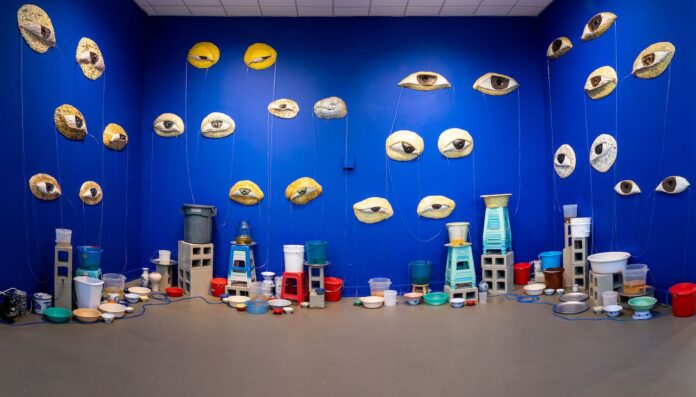Ceramicist Cathy Lu says she was thinking about garden creation myths when she dreamed up “Interior Garden,” the latest exhibition to be part of the Chinese Culture Center’s “XianRui (Fresh & Sharp)” series that features work by pioneering, mid-career artists of Chinese descent.
There are quite a few stories that tell of life among the leaves—the Garden of Eden being one, and the immortality-granting peaches of Chinese mythology, another. Inspired by them, the Miami-born, Richmond-based artist plays on tropes found in classical Chinese gardens, and also incorporates the ceramic headrests from her “American Dream Pillows” series.
On a walkthrough of the exhibition (which runs through December 17), Lu took us through the title of the show and its four installations, vision by vision.
WHAT IS THE “INTERIOR GARDEN”?
CATHY LU Starting around 2016, I had been thinking a lot about garden utopian creation stories. The president at the time kept saying, “Make America great again.” In my mind, I kept thinking, “When was this time period that America was great for everyone?” And of course, you’re like, “Oh yeah, it’s mythology. It’s not real.”
Even though I wasn’t brought up religious, everyone knows the story of the Garden of Eden. I started thinking, “Maybe this is what he’s referring to.” Actually, this story is not so great. It’s based on patriarchy, and this idea of innocence being good and knowledge is bad.
I started thinking about the immortal peach garden and Chinese culture, which is not a direct correlation, but a similar idea, this utopian garden where the mortals live. [The garden] also had this strong sense of borders, this idea that only certain people belong in there. I was like, “That’s the United States.” My parents are immigrants, they came to this country wanting to achieve this American dream. But then obviously once you’re here, you realize how difficult or dystopian it is to actually try to achieve those dreams.
That’s what this show is based on, and that’s why it’s called “Interior Garden.” I was thinking so much about this idea of racialized bodies, and how so much of that is a focus on what you look like externally. For immigrants, you always have to prove your worth—like, “I deserve to be here, I provide this labor.” That’s also focused on your external. Unfortunately there’s this real dehumanization, a total lack of focus on who you are internally.
And so that’s what I call the “interior garden.” Each of these four installations is based off of a trope in classical Chinese gardens.
“PILE”
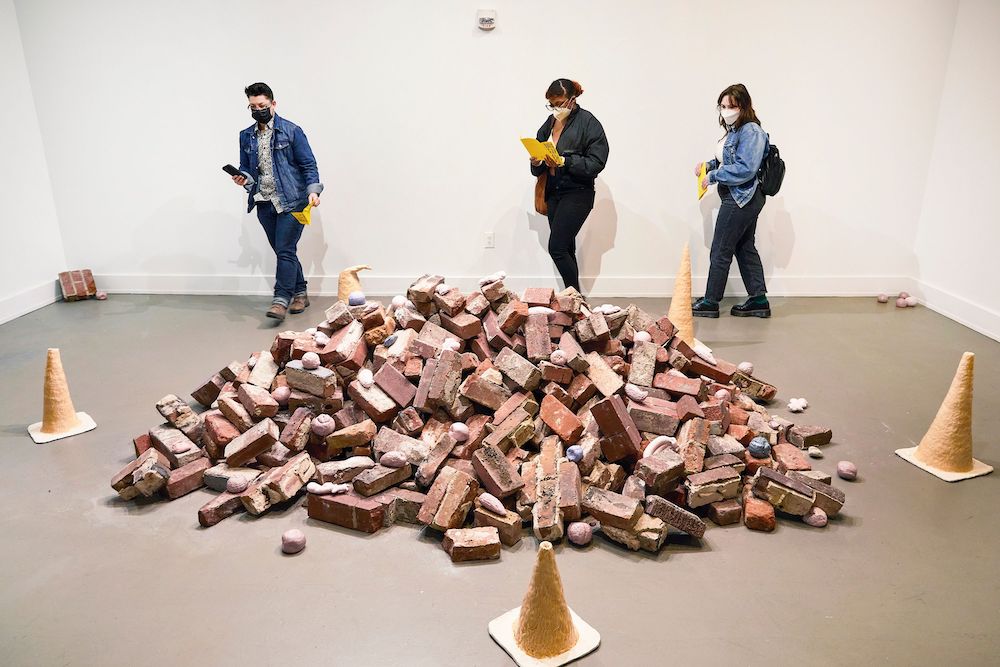
In 2017, I had a residency at Recology. While I was there, I was able to get all these materials, and there’s all these bricks coming in. There’s so much construction happening in the Bay Area.
At the same time, I was walking around Chinatown with a friend, and he was telling me about this brick facade on Grace Cathedral. The story is, after the 1906 earthquake, all the buildings burnt down, and the city was going to use that as a way to displace all the Chinese residents. When the Chinese residents heard about that, they came back and just start rebuilding themselves. And that’s why you see these buildings with these weird, shiny bricks sticking out of them that are very irregular. I thought it was really powerful that these burnt bricks, people, came back and just used what was considered garbage to actually maintain their ability to stay.
I started making the cones around like 2018, 2019 out of porcelain. I was thinking, again, about this idea of these utopian garden stories, and about borders. And then of course, about the United States and my upbringing in Miami, which is very much an immigrant community, at least the part I grew up in. There are these odd, border-like objects like you always see, the security fences and the traffic cones.
I’m always thinking about this idea of seeing ceramics in the museum, and how they have this sort of authority about them because they’re in the museum. A lot of times, we try to think of cultural representation or cultural objects, really grand things like the Statue of Liberty, to represent how we feel about immigration. But these are the objects we use, like traffic cones or security fences.
And [they are] temporary, which I think just sort of adds to the arbitrariness. You know, certain groups are good. It’s like, oh, no, they’re bad—now they’re good again. Anyway, that’s why I felt really compelled to make these traffic cones.
“PERIPHERAL VISION”
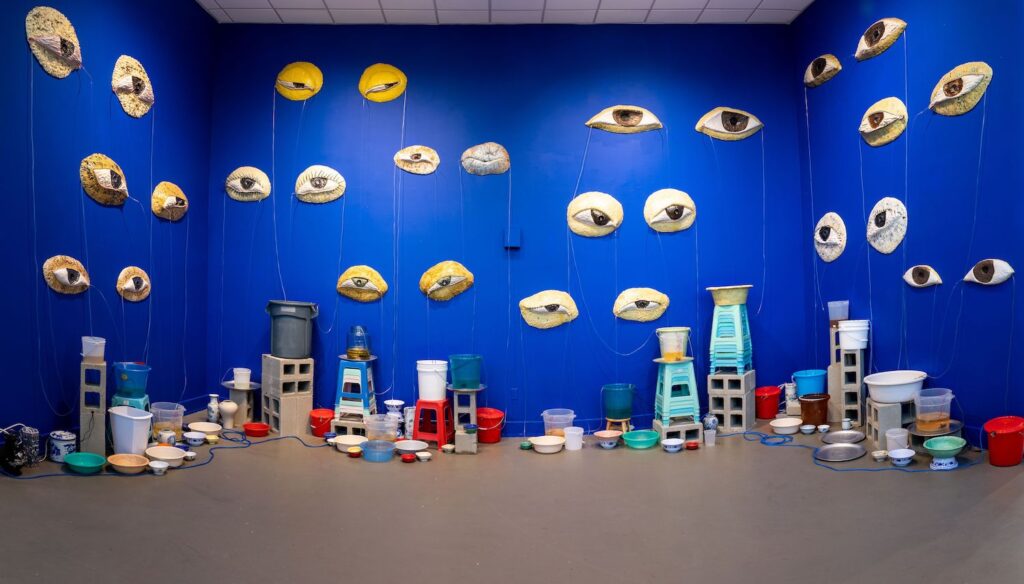
This is my version of a waterfall. I started thinking about this idea of white tears, and how racial dynamics in the United States are often framed as very Black and white. I think for Asian Americans as a community or group, it’s still new.
You know, we all speak different languages. What does it mean to be Asian American? How do I also play into these racial dynamics?
I started thinking about different East Asian women that informed my ideas of what it meant to be an East Asian American. A lot of these eyes actually correspond to different to people. There’s Ruth Asawa, there’s Maya Lin. But then I also have Christy Chan up there, too, who I know. And then, Cathy Park Hong, who wrote Minor Feelings, which was really influential in creating this work.
I also have things from my childhood, like, the yellow Power Ranger from the ’90s. And they’re all crying out yellow tears. Because, you know, with weird racial colors, I would be considered yellow. I also had been thinking about the mechanics of crying. When you cut onions, you cry. I started taking yellow onion skins and then boiling them in water, which becomes yellow. Then, I gathered containers. Some randomly, some of them are from my kitchen. Some are just ceramic bowls I had lying around my studio that I made but didn’t really do anything with them. Other objects I bought from Chinatown, different ceramic objects, different plastic buckets. The idea is, if it starts to rain suddenly, what do you do you? You just grab whatever containers, and you try to contain the water.
That was what I was going for, this idea of how to contain all these tears. I like making people see them. A lot of times these difficult emotions, you’re supposed to hide them and pretend that like, everything is cool. This is for me to make this crying super-visible.
These eyes are inspired by the woman the media called the fighting grandma. She was an elderly woman who was attacked on Market Street in 2021, and she fought back against her assailant. It was the first one I made.
“DRAINS”
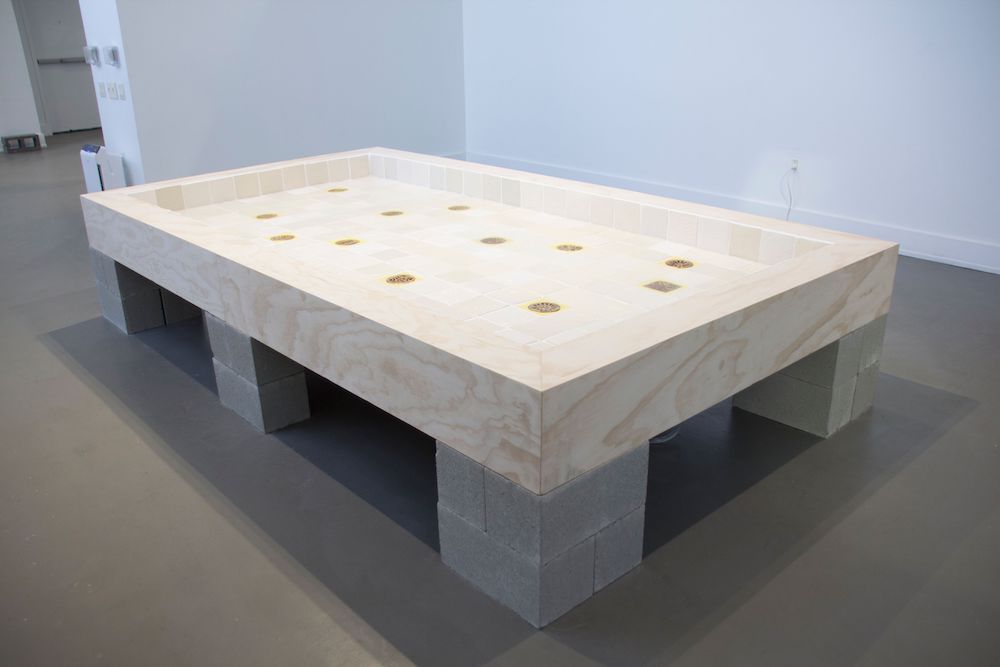
This piece is actually really weird for me, because I started making it without really understanding why. To a certain degree, I still don’t really understand why I made this.
I had been traveling in Jingdezhen to study porcelain in 2019, and I noticed that a lot of the Airbnbs I stayed at had really interesting drains in their bathrooms. It was kind of like this decorative site, and it’s not really like that in the US. The last Airbnb I stayed at the drain had a little happy face cut out. Also it just so happened that I was also living next to a drain store which sold a lot of faucets and decorative drains. Drains are also, to a certain degree, another barrier, a porous barrier between above and below ground.
When I had the opportunity to do this show, that’s when the idea came up to put them all together. I honestly still don’t understand this piece, but it did come out exactly the way I wanted it to. Each of the tiles are hand-pressed. I really wanted the labor to show, so it’s the fingerprints of me and the various people that were helping me, former students of mine, but like Jess Young, AJ Serrano, and Sophia Ramirez. They all helped me hand press these tiles. And my cat even must have jumped on one of the tiles when I wasn’t looking so her little cat paw prints are in there, too.
“NUWA’S HANDS”
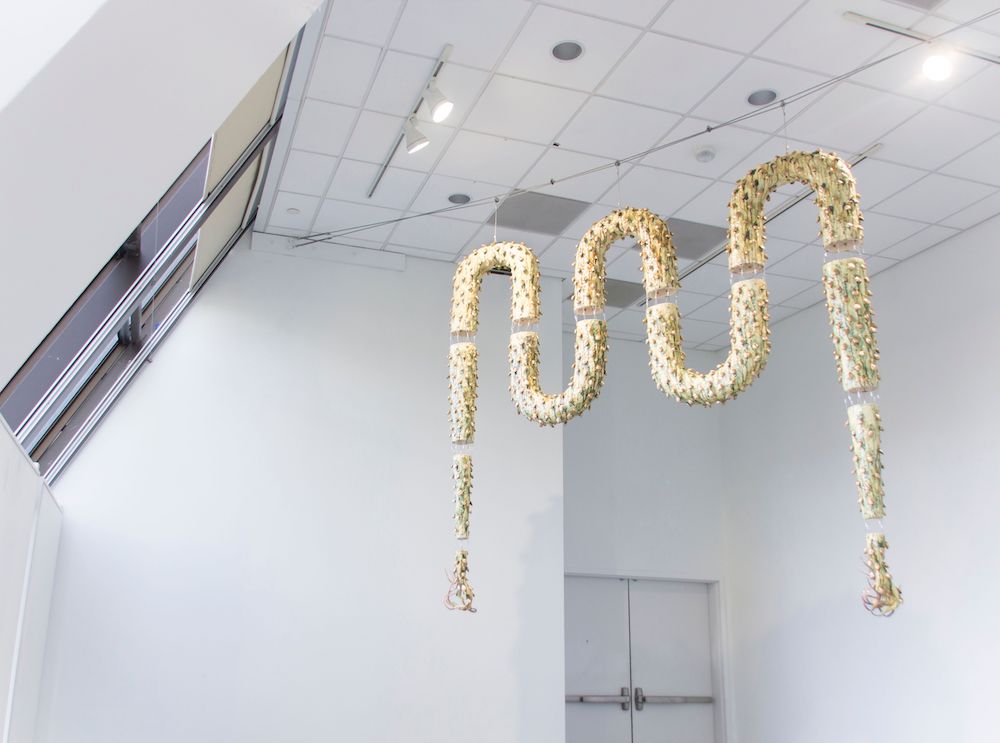
There’s a story about Nüwa the creation goddess. The idea was she was lonely, so she was making little figures out of clay or out of the earth. It was taking too long, so she stopped making the figures, and she just took a piece of string and then dragged it in the mud. And then when the mud dried on the string, she flicked it, and all the little pieces became people.
As someone who works with clay, I was like, “Oh, my God, she’s a ceramicist.” Just even the way she was producing. Like, you start a project, and you’re making something a certain way, and then you’re like, “Oh, gosh, there’s no way I’m going to get this done in time.” So, you switch gears, and I just found that really fascinating. If the world is not the way we want it to be, it’s up to us to create it to be the way we want it to be. I got really obsessed with her, and I kind of think of her as like this guide. I try to channel her spirit when I’m making my work.
“Interior Garden” runs through December 17 at the Chinese Culture Center of San Francisco. More info here.

